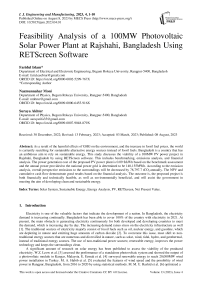Feasibility Analysis of a 100MW Photovoltaic Solar Power Plant at Rajshahi, Bangladesh Using RETScreen Software
Автор: Faridul Islam, Nazmunnahar Moni, Suraya Akhter
Журнал: International Journal of Engineering and Manufacturing @ijem
Статья в выпуске: 4 vol.13, 2023 года.
Бесплатный доступ
As a result of the harmful effects of GHG on the environment, and the increase in fossil fuel prices, the world is currently searching for sustainable alternative energy sources instead of fossil fuels. Bangladesh is a country that has an ambitious aim to rely on sustainable energy. This study discusses the viability of a 100MW PV power project in Rajshahi, Bangladesh by using RETScreen software. This includes benchmarking, emissions analysis, and financial analysis. The power generation cost of the proposed PV power plant is 0.09 $/kWh based on the benchmark assessment and the annual power provided to the national power grid is determined to be 140,155MWh. According to the emission analysis, overall perspective emissions to the surroundings will be decreased by 78,797.7 tCO2 annually. The NPV and cumulative cash flow demonstrate good results based on the financial analysis. The outcome is, the proposed project is both financially and technically feasible, as well as environmentally beneficial, and will assist the government in meeting the aim of developing clean and sustainable energy.
Solar System, Sustainable Energy, Energy Analysis, PV, RETScreen, Net Present Value
Короткий адрес: https://sciup.org/15018701
IDR: 15018701 | DOI: 10.5815/ijem.2023.04.01
Текст научной статьи Feasibility Analysis of a 100MW Photovoltaic Solar Power Plant at Rajshahi, Bangladesh Using RETScreen Software
Electricity is one of the valuable factors that indicate the development of a nation. In Bangladesh, the electricity demand is increasing continually. Bangladesh has been able to cover 100% of the country with electricity in 2021. At present, the main obstacle is generating electricity continuously for both developed and developing countries to meet the demand, which is increasing day by day. The increasing demand raises stress on the electricity infrastructure as well [1]. The traditional sources of electricity majorly consist of fossil fuels such as oil, nuclear energy, and gasoline, which are depleting in nature and emitting huge amounts of carbon dioxide [2]. To overcome this issue, must shift to non-traditional energy sources that are numerous and diversified in nature, such as solar, wind, tidal, hydro, and geothermal, instead of traditional energy sources. The use of non-traditional power sources; renewable energy, improves the power technology and keeps the surroundings clean.
A significant amount of research on solar energy has been published to assess the viability of the produced electricity. W.Z. Leow et al. [3] assessed the performance of a standalone photovoltaic system and showed the output of a photovoltaic module in Kangar, Malaysia. E. Ermak et al. [4] surveyed renewable energy to reach 20,000MW wind power installation in Turkey. M. A. Habib et al. [5] evaluated the features of wind speed and the possibility of wind power in Rangpur, Bangladesh, from 2016 to 2020 by using statistical methods. M. M. U. Rashid et al. [6] optimized a hybrid power system into the procedure for determining the optimum components and sizing these with a suitable operating strategy to deliver inexpensive, effective, dependable, and cost-acceptable alternate energy utilizing HOMER. M. I. Yuce et al. [7] analyzed all the variables of small-scale hydropower plants (SHPs) to determine the best-installed capacity and plant cost. J. Swart et al. [8] used RETScreen software as a guide to install and design sustainable PV systems with the distinctive climate of a particular region in South Africa. Z. Mingzhi et al. [9] analyzed the capacity of electricity generation and the cost per kWh of electricity generation based on various solar energy resource data in Mongolia. S. Mukherjee et al. [10] studied the technical and financial parameters of a grid-connected 100kW PV solar system with design parameters in the eight divisions of Bangladesh. A. Naithani et al. [11] compared life span cost of an electrification model (off-grid) on the basis of solar cells with the current grid-connected power cost in Kasai village of India. R. Samu et al. [12] presented a model to install a 10MW solar PV system by considering technical and economical parameters such as simple payback, equity payback, capacity factor, net present value, annual life cycle savings, and the cost of energy production. M. Agrawal et al. [13] estimated the feasibility parameters of a 100kW rooftop grid-connected solar PV system in Rajasthan with the help of RETScreen software. H.M. Rafeed Leon et al. [14] represented the design of an autonomous hybrid energy system with the analysis of economic feasibility for rural areas in Bangladesh. K. N. Nikita et al. [15] proposed to set up a 13MW solar power system in a suitable marshy land of Bangladesh by analyzing technical and financial parameters with the help of RETScreen software. M. Ahmed et al. [16] proposed a wind energy model to generate the integration system in Cox's bazaar of Bangladesh. Z. A. Khan et al. [17] investigated the assessment of the techno-economic analysis to install a 50MW wind farm at Pasni, Pakistan, employing ARIMA Models and RETScreen software. M. Mathew et al. [18] discussed the technological and financial viability to generate electricity from a 1MW of solar power plant in Dhanbad, Jharkhand of India. A. Khandelwal et al. [19] described the performance, financial, and emission assessment of a grid-connected solar system of a 600kW power plant to promote the adoption of PV systems in a village in Rajasthan, India. M. M. Omrani et al. [20] examined a techno-economic assessment for a suitable location to set up a large-scale solar PV power plant in southeastern Iran. A. Adam et al. [21] proposed a stand-alone PV system with the viability of the economy and the environmental effect of the system in Cameroon. H. M. A. Rehman et al. [22] evaluated the technological and economic analysis of several types of water heating using solar collectors for domestic requirements in Saudi Arabia with the help of RETScreen Software. V. Applasamy [23] calculated the cost of a stand-alone PV power system for the home using RETScreen software in Malaysia. M. Agrawal et al. [24] calculated the potential of solar energy for establishing the power plant of the solar photovoltaic system by considering the location in Rajasthan, India. N. M. Swaarnkar et al. [25] optimized the economic analysis of a hybrid energy system to supply electricity for domestic purposes using Homer and RETScreen software in Rajasthan of India. S. Mukherjee et al. [26] analyzed the grid-connected PV solar system of a 100kW power plant in the eight divisions of Bangladesh along with a number of financial features to conclude the possibility of the proposed system. M. Khatami et al. [27] designed an off-grid PV solar system to supply electricity for domestic purposes in Iran by using RETScreen software.
Including benchmark analysis, energy analysis, financial viability, emission analysis, net present value (NPV), cumulative cash flow, and annual cash flow issues depending on the application of solar energy; J. Baccay Sy et al. [28] assessed the viability study of a 100MW solar PV power plant at Bati, Ethiopia to achieve the goal of building clean energy in the country. This analysis was assessed in Bati, Ethiopia, but precisely, almost no such investigation has been estimated in Rajshahi of Bangladesh. Thus, this analysis evaluates the feasibility analysis of a 100MW solar PV power plant at Rajshahi of Bangladesh as demonstrated in Table 1.
This study evaluates the feasibility analysis of a 100MW solar PV power plant system in Rajshahi of Bangladesh. The study assesses the benchmark analysis, energy analysis, financial viability, emission analysis, annual cash flow, cumulative cash flow, net present value, and sensitivity analysis by using RETScreen software.
The remainder of this analysis continues as follows: Section 2 contains methodology; Section 3 includes results and discussion; Section 4 indicates the conclusion.
2. Methodology 2.1. Facility and Climate Data Location
Table 1 shows the facility and climate data location of the proposed PV power plant which is traced in Rajshahi of Bangladesh. The latitude and longitude of the selected location are 24.40N and 88.60E respectively. The place is preferred based on climatic parameters that can be used to explain the possibility of the proposed system using benchmark analysis, and the meteorological data, included in Table 2. The daily solar radiation on average of the selected location is 4.87kWh/m2 which is a significant amount of solar radiation that may be used to generate electricity.
The elevation of the facility location is 22 m above the surface of the ocean. To execute the exact figures of the feasibility analysis, the climatic data is extended to this elevation, which is shown in Table 2. According to Table 2, the place is technically favorable to generate electricity.
Table 1. Facility and climate data location.
|
Name |
Climate data location |
Facility location |
Unit |
|
Bangladesh- Rajshahi |
Bangladesh |
||
|
Latitude |
24.4 |
24.4 |
o N |
|
Longitude |
88.6 |
88.6 |
o E |
|
Climate zone |
1A-Very hot- Humid |
1A-Very hot- Humid |
|
|
Elevation |
18 |
22 |
m |
Table 2. Facility and climate data location.
|
Month |
Air temperature (oC) |
Relative humidity (%) |
Precipitation (mm) |
Daily solar radiation horizontal (kWh/m2/d) |
Atmospheric pressure (kPa) |
Wind speed (m/s) |
Earth temperature (oC) |
Heating degreedays 18 oC (oC-d) |
Cooling degreedays 10 oC (oC-d) |
|
January |
17.7 |
46.9 |
5.58 |
4.32 |
101.3 |
2.5 |
17.4 |
9 |
239 |
|
February |
21.8 |
37.6 |
8.96 |
5.25 |
101.1 |
2.6 |
21.8 |
0 |
330 |
|
March |
27.4 |
30.6 |
17.05 |
5.95 |
100.7 |
2.8 |
28.1 |
0 |
539 |
|
April |
31.7 |
38.6 |
41.70 |
6.33 |
100.4 |
3.0 |
33.1 |
0 |
651 |
|
May |
32.5 |
53.0 |
102.61 |
5.74 |
100.1 |
3.5 |
34.2 |
0 |
698 |
|
June |
31.0 |
70.1 |
162.00 |
5.04 |
99.7 |
4.1 |
32.0 |
0 |
630 |
|
July |
29.3 |
81.1 |
199.64 |
4.41 |
99.8 |
3.9 |
29.8 |
0 |
598 |
|
August |
29.0 |
82.2 |
170.50 |
4.36 |
99.9 |
3.5 |
29.4 |
0 |
589 |
|
September |
28.1 |
83.0 |
171.00 |
4.03 |
100.3 |
3.0 |
28.4 |
0 |
543 |
|
October |
26.3 |
75.1 |
92.07 |
4.42 |
100.8 |
2.2 |
26.5 |
0 |
505 |
|
November |
22.5 |
65.2 |
10.80 |
4.46 |
101.1 |
2.2 |
22.4 |
0 |
375 |
|
December |
18.5 |
58.0 |
4.65 |
4.21 |
101.3 |
2.4 |
18.2 |
0 |
264 |
|
Annual |
26.3 |
60.3 |
986.56 |
4.87 |
100.5 |
3.0 |
26.8 |
9 |
5,961 |
2.2. The Capacity of Power Plant
The government of Bangladesh has established the goal of increasing installed capacity power generation will be increased to 40,000MW by 2030 and 60,000MW by 2041, according to the Power System Master Plan (PSMP) 2016 [29]. In 2021, the government of Bangladesh provided all residents with 100 percent electricity [29]. To achieve this figure, the potential and feasibility analysis are necessary to assist the government and relevant power sector, entrepreneurs. As a result, this analysis will potentially provide 100MW of electricity to the national grid and will play a significant role in assisting the country in meeting the target by 2041.
2.3. Software Used
3. Result and Discussion
3.1. Benchmark Analysis3.2. Energy Analysis
To assess this PV power system, RETScreen Expert software was used which is a solution for a clean energy management system for analyzing renewable energy, energy proficiency, the project viability of power generating, and continuous energy performance. The RETScreen Expert software is a set of three primary analysis tools; benchmark analysis, feasibility analysis, and performance analysis. As a result, all the feasibility analyses of the proposed system are performed using RETScreen Expert software.
The benchmark analysis is a precise form of marketing strategy that allows firms to evaluate the current performance in contrast to others and improve processes that are consistent with the entire approach to continuous enhancement and environment [30]. Fig. 1 shows the benchmark analysis of the proposed system. According to Fig. 1, the cost of producing energy is 0.09 $/kWh which is significantly cheaper than the current power generation sources of the country. Consequently, the proposed PV power plant in Rajshahi of Bangladesh is financially viable, and this favorable outcome motivates future economic assessments.
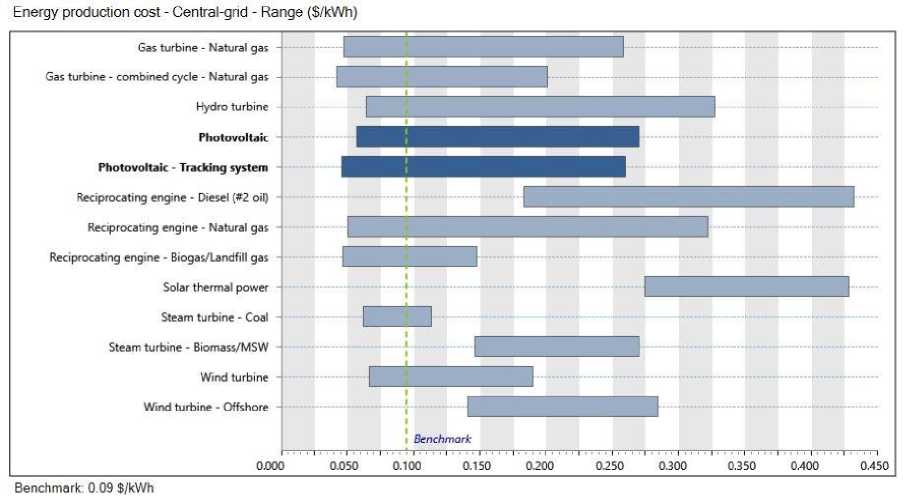
Fig. 1. Benchmark analysis.
The energy assessment has been analyzed on the basis of the benchmark analysis in part 3.1 as well as the climatic information in segment 2.1. The intended capacity of the power plant is 100MW, implying that the power plant should consistently produce 100MW of electricity to the power grid. Unfortunately, the irradiation of solar energy varies on a daily basis as well as an hourly basis. So, achieving constant electricity generation is tough. Table 3 displays the energy capacity in terms of the projected solar power system. According to the capability of energy analyses, the determined capacity of the proposed power plant is 100MW, and the power provided to the local power grid is determined to be 140,155MWh.
Table 3. Energy Capacity.
|
PV-100 MW |
||
|
Properties |
Value |
Unit |
|
Capacity |
100,000 |
kW |
|
Electricity |
140,155 |
MWh |
-
3.3. Financial Viability
-
3.4. Emission Analysis
As stated by [28], economic feasibility is the capacity to produce enough revenue to pay operational expenses, and debts, when relevant, to permit growth and conserve service quality. As a result, the economic feasibility of the proposed power plant is reviewed in this section. The financial parameters are the factors that determine whether or not a project is financially viable. Table 4 shows these financial parameters. The financial viability process depends on the contribution of the appropriate assumptions about the project life, the inflation rate, the reinvestment rate, and the discount rate. Table 4 summarizes all costs and debt payments on a yearly basis. The project needs to pay $9,222,748 per year.
Table 4. Financial parameters.
|
General |
||
|
Name |
Value |
Unit |
|
Inflation rate |
2 |
% |
|
Discount rate |
9 |
% |
|
Reinvestment rate |
9 |
% |
|
Project life |
20 |
years |
|
Finance |
||
|
Name |
Value |
Unit |
|
Debt ratio |
70 |
% |
|
Debt |
84,000,000 |
$ |
|
Equity |
36,000,000 |
$ |
|
Debt interest rate |
7 |
% |
|
Debt term |
15 |
years |
|
Debt payments |
9,222,748 |
$/year |
The feasibility is then analyzed consuming a yearly revenue analysis, as shown in Table 5. According to Table 5, the rate of electricity export is 0.10 $/kWh, and annually electricity supplied to the local grid is 140,155MWh. The export of electricity escalation rate is 2% and the annually electricity export revenue is $14,015,512.
Table 5. Annual revenue.
|
Electricity export revenue |
||
|
Name |
Value |
Unit |
|
Electricity exported to grid |
140,155 |
MWh |
|
Electricity export rate |
0.10 |
$/kWh |
|
Electricity export revenue |
14,015,512 |
$ |
|
Electricity export escalation rate |
2 |
% |
The primary goal of implementing sources of renewable energy as a power source is to minimize greenhouse gas emissions, and this analysis explores how much GHG will be decreased. Fig. 2 shows the GHG emission reduction. The total yearly greenhouse gas reduction is around 93%, which is a significant amount. The proposed power plant will reduce GHG emissions from 84,924.4 tCO2 to 5,944.7 tCO2 annually.
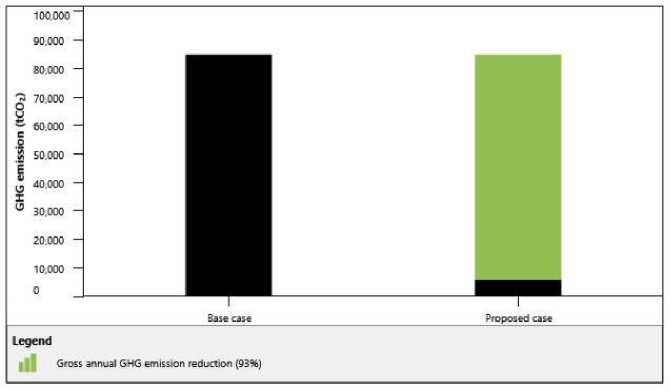
Fig. 2. GHG emission reduction.
The government is moving toward exclusively green energy and has already begun several great initiatives to capitalize on solar and wind energy. This figure represents the photovoltaic potential and motivates the government and investors to pursue alternate methods of generating power from solar energy. Fig. 3 shows the GHG equivalence of gross reduction in annual GHG emissions. The gross reduction in annual GHG emissions is 78,797.7 tCO2 which is comparable to 183,673.8 crude oil barrels that are not used.
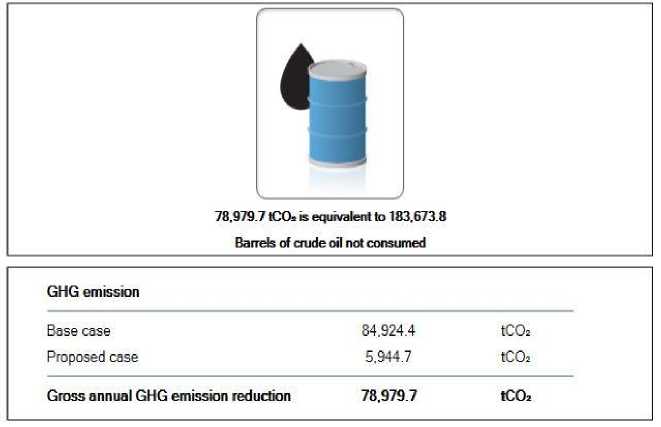
Fig. 3. GHG equivalence.
-
3.5. Annual Cash flow and Cumulative Cash Flow
-
3.6. Sensitivity Analysis
Annual cash flow describes the net income of a company from amicus division activities before interest, taxes, debt service, depreciation, and amortization ("Net Income"), computed quarterly over a twelve-month period [31]. The cumulative and yearly cash flow assessment has been done based on the electricity supplied to the local grid, the revenue of the electricity export, and the reduction in GHG emission along with other parameters. Fig. 4 shows the annual cash flow.
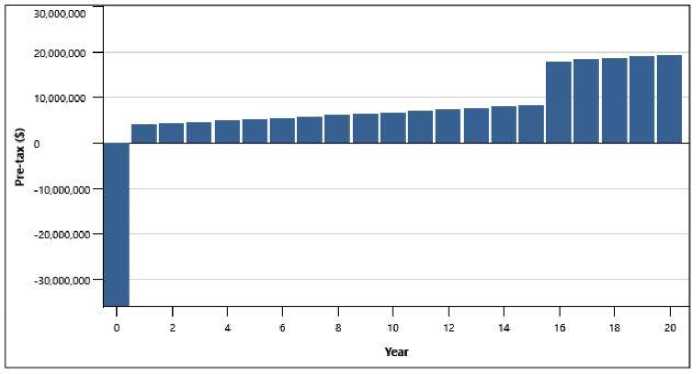
Fig. 4. Annual cash flow.
The concept of "cumulative cash flow" can be used in enterprises or projects. The cumulative cash flow is calculated by adding all of the cash flows that have occurred since the project or business began [32]. Fig. 5 shows the cumulative cash flow. The statistics actually demonstrate that the cash flow has been positive since the beginning, with the exception of the first 7 years of the project's execution, and the project's profitability is not in dispute.
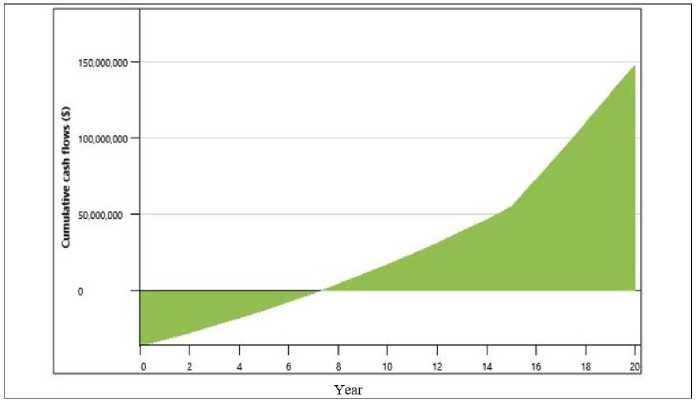
Fig. 5. Cumulative cash flow.
Sensitivity analysis is a financial model that compares the goal variables to the input parameters or other factors. By considering two entered factors to the estimated financial parameters the sensitivity analysis worksheet decreases the amount of uncertainty. The sensitivity worksheet is shown in Fig. 6 for the net present value (NPV) of the proposed project. The initial investment was compared to the loan rate for scenario 1 by about ±25% range, and the initial investment was compared to the power supplied to the local grid for scenario 2 by about the equivalent range.
The starting cost was calculated in contradiction of debt interest rate by ±25% range which is shown in scenario 1 and the starting cost was calculated in contradiction of electricity export to the grid by the same range which is shown in scenario 2. The initial cost in scenerio1 is estimated to be $120,000,000 with a ±25% discount. The initial costs will be $150,000,000 and $90,000,000, respectively. The original debt rate of interest is 7%, but with a ±25% increase, the debt interest rate is 8.75% and 5.25%, separately. To indicate NPV values below zero levels, the software specifies the color orange. With a 25% increase in the initial cost and a 25% decrease in the debt interest rate, the project will still not be financially viable since the NPV would be -$3,758,078. The project will be financially feasible if the original cost is reduced by 25% and the debt interest rate is increased by 25% since the NPV will be much higher than zero.
Consequently, in the latter scenario, when the initial cost is compared to the amount of electricity supplied to the local grid. In both cases, the initial cost has a much greater impact on the Net Present Value (NPV) than the debt interest rate and the amount of electricity supplied to the local grid.
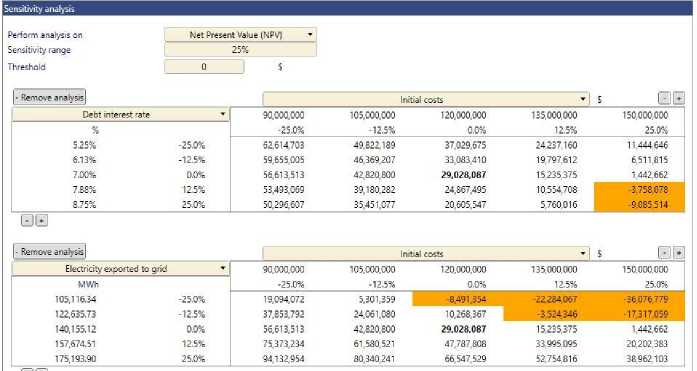
Fig. 6. Sensitivity worksheet.
-
3.7. Net Present Value (NPV)
The term "net present value" refers to the difference between the current values of cash inflows and outflows over time. A positive or negative return on investment and the analysis are shown by the net present value. This research was conducted according to the relevant effects of the factors on the NPV. Fig. 7 depicts the respective impact of various factors on NPV.
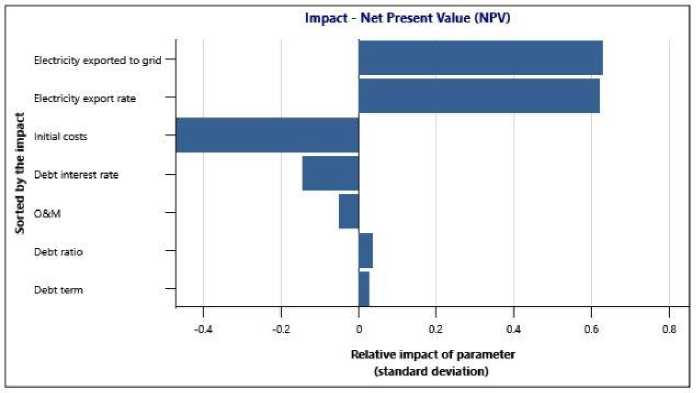
Fig. 7. Parameters impact on NPV.
This histogram shows the distribution of potential values for the financial indicator as determined by the Monte Carlo simulation. The height of each bar shows the percentage of values that fall inside the range given by the width of each bar. On the X-axis, a value is plotted that represents the midpoint of each range. [30]. Fig. 8 represents the distribution of the NPV. The project provides a positive return due to the influence of the parameters and the NPV value remaining positive.
Distribution - Net Present Value (NPV)
10%
9%
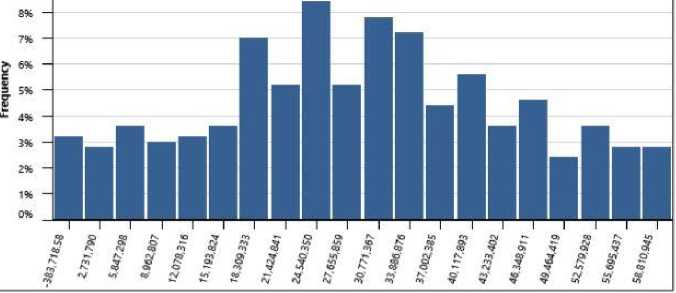
Fig. 8. Distribution of NPV.
4. Conclusion
A feasibility study was performed to estimate the performance of installing a 100MW of solar power plant with the grid-connected photovoltaic system in Rajshahi, Bangladesh, based on the effects of technical, sensitivity, financial, risk, and the environment via this project. The electricity-producing cost of the proposed PV power plant is 0.09 $/kWh. The NPV and cash flow both indicate optimistic results. The intended power plant will decrease GHG emissions from 84,924.4 tCO 2 to 5,944.7 tCO 2 annually. This data indicates that the facility has a significant contribution to decreasing GHG emissions. The above points lead to the conclusion that the project is technically, financially, and environmentally feasible. This will be essential for achieving the target by 2041 of the country.
Список литературы Feasibility Analysis of a 100MW Photovoltaic Solar Power Plant at Rajshahi, Bangladesh Using RETScreen Software
- Rekhashree, Dr. J.S Rajashekar, and Dr.H. Naganagouda, “Study on Design and Performance Analysis of Solar PV Rooftop Standalone and On Grid System Using PVSYST,” International Research Journal of Engineering and Technology (IRJET), volume: 5, Issue: 7, July 2018.
- K. C. Rout and PS Kulkarni, “Design and Performance evaluation of Proposed 2 kW Solar PV Rooftop on Grid System in Odisha using PVsyst,” 2020 IEEE International Students' Conference on Electrical, Electronics and Computer Science (SCEECS), pp. 1-6, 2020. Doi: 10.1109/SCEECS48394.2020.124.
- W.Z. Leow, Y.M. Irwan, M. Irwanto, A.R. Amelia, and I. Safwati, “Influence of wind speed on the performance of photovoltaic Panel” Indonesian Journal of Electrical Engineering and Computer Science, Vol. 15, No. 1, pp. 60-68, 2018. Doi: 10.11591/ijeecs.v15.i1.pp60-68.
- E. Irmak, M. S. Ayaz, S. G. Gok, and A. B. Sahin, “A survey on public awareness towards renewable energy in Turkey,” 2014 International Conference on Renewable Energy Research and Application (ICRERA), pp. 932-937, 2014. Doi: 10.1109/ICRERA.2014.7016523.
- M. A. Habib, “Wind speed data and statistical analysis for Rangpur district in Bangladesh.” Journal of Electrical Engineering, Electronics, Control and Computer Science, Volume 8, Issue 30, pp. 1-10, 2022.
- M. M. U. Rashid, M. M. Rahman, M. A. Habib, and M. M. Hasan, “Study and analysis of hybrid energy options for electricity production in Rangpur, Bangladesh.” Asian Journal of Current Research, 3(1), 9-14, 2018.
- M. I. Yuce and S. Yuce. “Pre-Feasibility Assessment of Small Hydropower Projects in Turkey by RETScreen.” Journal (American Water Works Association), vol. 108, no. 5, pp. E269–75, 2016, JSTOR, https://www.jstor.org/stable/jamewatworass.108.5.e269. [Accessed 26 Nov. 2022.]
- J. Swart, R. Schoeman, and C. Pienaar, “Ensuring sustainability of PV systems for a given climate region in South Africa,” 2013 Africon, pp. 1-5, 2013. Doi: 10.1109/AFRCON.2013.6757638.
- Z. Mingzhi, L. Zhizhang, and Z. Qingzhu, “Testing and Analyzing of Solar Energy Resource,” 2010 Asia-Pacific Power and Energy Engineering Conference, pp. 1-3, 2010. Doi: 10.1109/APPEEC.2010.5449466.
- S. Mukherjee and M. A. Razzak, “Design, analysis and optimization of grid-connected solar photovoltaic system using RETScreen in eight divisions of Bangladesh,” 2016 3rd International Conference on Electrical Engineering and Information Communication Technology (ICEEICT), pp. 1-6, 2016. Doi: 10.1109/CEEICT.2016.7873120.
- A. Naithani, S. Thakur, and A. M. Khalkho, “Feasibility study for electrification project in Kasai village (Madhya Pradesh) in India,” 2017 4th International Conference on Electronics and Communication Systems (ICECS), pp. 101-105, 2017. Doi: 10.1109/ECS.2017.8067847.
- R. Samu, G. Poyrazoglu, and M. Fahrioglu, “The Potential and Economic Analysis of Grid-connected Solar PV Power in Kenya,” 2019 1st Global Power, Energy and Communication Conference (GPECOM), pp. 298-301, 2019. Doi: 10.1109/GPECOM.2019.8778467.
- M. Agrawal, B. K. Saxena, and K. V. S. Rao, “Estimation of energy production and net metering of Grid connected rooftop photovoltaic system in Rajasthan,” 2017 International Conference on Circuit, Power and Computing Technologies (ICCPCT), pp. 1-6, 2017. Doi: 10.1109/ICCPCT.2017.8074181.
- H. M. R. Leon, M. A. Shoeb, M. S. Rahman, M. U. Ahmed, and M. S. Islam, “Design and economic feasibility analysis of autonomous hybrid energy system for rural Bangladesh,” 2016 4th International Conference on the Development in the in Renewable Energy Technology (ICDRET), pp. 1-6, 2016. Doi: 10.1109/ICDRET.2016.7421503.
- K. N. Nikita, S. N. Islam, M. S. Islam, M. Saha, and M. F. Khan, “Prospect of solar PV based power generation in the marshy lands of Bangladesh: An analysis through RETScreen software,” 2016 4th International Conference on the Development in the in Renewable Energy Technology (ICDRET), pp. 1-6, 2016. Doi: 10.1109/ICDRET.2016.7421529.
- M. Ahmed, M. S. Parvez, and M. M. Hossain, “Integration of wind power in smart grid, perspective: Cox’s Bazaar (Bangladesh),” 2015 International Conference on Electrical Engineering and Information Communication Technology (ICEEICT), 2015. Doi: 10.1109/iceeict.2015.7307351.
- Z. A. Khan and R. Wazir, “Techno-economic study for 50 MW wind farm in Pasni, coastal district of Balochistan-Pakistan using ARIMA models and RETScreen,” 2014 International Conference on Energy Systems and Policies (ICESP), pp. 1-5, 2014. Doi: 10.1109/ICESP.2014.7347012.
- M. Mathew, Y. K. Sharma, and M. A. Magry, “Design and analysis of solar photovoltaic based coal mine reclamation in India,” 2017 International Conference on Intelligent Computing, Instrumentation and Control Technologies (ICICICT), pp. 372-375, 2017. Doi: 10.1109/ICICICT1.2017.8342592.
- A. Khandelwal and V. Shrivastava, “Viability of grid-connected solar PV system for a village of Rajasthan,” 2017 International Conference on Information, Communication, Instrumentation and Control (ICICIC), pp. 1-6, 2017. Doi: 10.1109/ICOMICON.2017.8279175.
- M. M. Omrani, M. Zandi, S. Pierfederici, and Maziyar Mirzaei Omrani, “Investigation of an Appropriate Location for Construction the Large-Scale Photovoltaic Power Plant in Southeastern Iran,” 2019 Iranian Conference on Renewable Energy & Distributed Generation (ICREDG), pp. 1-6, 2019. Doi: 10.1109/ICREDG47187.2019.194155.
- A. Adam, N. M. Galal, and M. S. Hamad, “Rural electrification using a stand-alone photovoltaic system: Case study of Cameroon,” 2015 International Conference on Industrial Engineering and Operations Management (IEOM), pp. 1-8, 2015. Doi: 10.1109/IEOM.2015.7093756.
- H. M. A. Rehman and F. A. Al-Sulaiman, “Techno-economic evaluation of different types of solar collectors for water heating application in domestic sector of Saudi Arabia,” 2014 5th International Renewable Energy Congress (IREC), pp. 1-6, 2014. Doi: 10.1109/IREC.2014.6826977.
- V. Applasamy, “Cost evaluation of a stand-alone residential photovoltaic power system in Malaysia,” 2011 IEEE Symposium on Business, Engineering and Industrial Applications (ISBEIA), pp. 214-218, 2011. Doi: 10.1109/ISBEIA.2011.6088807.
- M. Agrawal, B. K. Saxena, and K. V. S. Rao, “Feasibility of establishing solar photovoltaic power plants at existing wind farms,” 2017 International Conference On Smart Technologies For Smart Nation (SmartTechCon), pp. 251-256, 2017. Doi: 10.1109/SmartTechCon.2017.8358378.
- N. M. Swarnkar and L. Gidwani. “Analysis of hybrid energy system for supply residential electrical load by HOMER and RETScreen: A case in Rajasthan, India.” In 2016 International Conference on Recent Advances and Innovations in Engineering (ICRAIE), pp. 1-6. IEEE, 2016.
- S. Mukherjee and M. A. Razzak, “Analysis of 100 kW grid-connected solar photovoltaic system developed on the river deltas of eight divisions of Bangladesh using RETScreen,” 2017 International Conference on Electrical, Computer and Communication Engineering (ECCE), pp. 350-355, 2017. Doi: 10.1109/ECACE.2017.7912930.
- M. Khatami, H. Mortazavi, M. R. Mashhadi, and M. Oloomi, “Designing an off-grid PV system: For a residential consumer in Mashhad-Iran,” 2013 Africon, pp. 1-5, 2013. Doi: 10.1109/AFRCON.2013.6757680.
- J. Baccay Sy, A. Haile, and W. Degife. “Feasibility Study of a 100MW Photovoltaic Power plant at Bati, Ethiopia Using RETScreen.” International Journal of Scientific and Research Publications 10, no. 9, pp. 44-51, 2020.
- “Bangladesh Economic Review 2022, Chapter Ten, Power and Energy.” Available at: https://mof.portal.gov.bd/sites/default/files/files/mof.portal.gov.bd/page/f2d8fabb_29c1_423a_9d37_cdb500260002/19_BER_22_En_Chap10.pdf
- “RETScreen | Natural Resources Canada.” [Online]. Available: https://www.nrcan.gc.ca/maps-tools-publications/tools/dataanalysis-software-modelling/retscreen/7465. [Accessed: December 28, 2022].
- “Annual Cash Flow definition”. Available at: https://www.lawinsider.com/dictionary/annual-cash-flow
- “What does the cumulative cash flow mean?” Available at: https://www.quora.com/What-does-the-cumulative-cash-flow-mean. [Accessed: December 28, 2022].

